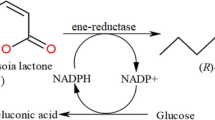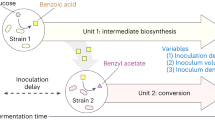Abstract
The microbial oxidation of ebastine to carebastine was investigated. Among the 15 micro-organisms examined, only theCunninghamella strains showed the desired biotransformation.Cunninghamella blakesleeana oxidised the substrate within 7 days, via the intermediates alcohol and aldehyde, mainly to carebastine, the corresponding carboxylic acid. Optimisation of the culture conditions increased the yield from initially 10% up to a reproducible 40%. For the synthesis of carebastine a substrate concentration of 200 mg/l, a starting pH of 5.0 and the addition of 1% poly(vinyl alcohol) is favourable. The results achieved in experiments with shaking flasks are transferable to the fermentation scale and yielded 270 mg carebastine in a 3-l fermentation of 600 mg ebastine. The progress of the reaction was detected by TLC and HPLC, the products were identified by mass spectrometry and NMR.
Similar content being viewed by others
References
Cerniglia CE, Lambert KJ, Miller DW, Freeman JP (1984) Transformation of 1- and 2-methylnaphthalene byCunninghamella elegans. Appl Environ Microbiol 47:111–118
Cerniglia CE, Campbell WJ, Fu PP, Freeman JP, Evans FE (1990) Stereoselective fungal metabolism of methylated anthracenes. Appl Environ Microbiol 56:661–668
Clarke AM, Hufford CD (1991) Use of microorganisms for the study of drug metabolism: an update. Med Res Rev 11:473–501
Clarke AM, McChesney JD, Hufford CD (1985) The use of microorganisms for the study of drug metabolism. Med Res Rev 5:231–253
Elmayergi H, Schrader JM, Moo-Young M (1973) Effects of polymer additives on fermentation parameters in a culture ofA. niger. Biotechnol Bioeng 15:845–859
Dislerath LM, Guengerich FP (1987) Enzymology of human liver cytochromesP-450. In: Guengerich FP (ed) Mammalian cytochromesP-450, vol 1. CRC, Boca Raton Fla, pp 133–198
Fujii T, Matsumoto S, Amejima H, Nakao M, Kagemoto A, Tanaka K, Miyazaki H (1994) Absorption, distribution, metabolism and excretion of [14C] ebastine after a single administration in rats. Arzneimittelforschung/Drug Res 44:527–538
Griffiths DA, Best DJ, Jezequel SG (1991) The screening of selected microorganisms for use as models of mammalian drug metabolism. Appl Microbiol Biotechnol 35:373–381
Guengerich FP (1987) Enzymology of rat liver cytochromesP-450. In: Guengerich FP (ed) Mammalian cytochromesP-450, vol 1. CRC, Boca Raton, Fla, pp 1–55
Heitkamp MA, Freeman JP, McMillan DC, Cerniglia CE (1985) Fungal metabolism oftert-butylphenyl diphenyl phosphate. Appl Environ Microbiol 50:265–273
Hotop S, Möller J, Niehoff J, Schügerl K (1993) Influence of the preculture conditions on the pellet size distribution ofPenicilliun chrysogenum cultivations. Process Biochem 28:99–104
Johnson RA, Hall CM, Krueger WC, Murray HC (1973) Microbial oxygenation of dialkylbenzenes (I). Bioorg Chem 2:99–110
Matsuda M, Sakashita M, Mizuki Y, Yamaguchi T, Fujii T, Sekine Y (1994) Comparative pharmacokinetics of the histamine H1-receptor antagonist ebastine and its active metabolite carebastine in rats, guinea pigs, dogs and monkeys. Arzneimittelforschung/Drug Res 44:55–59
Metz B, Kossen NWF (1977) The growth of molds in the form of pellets. Biotechnol Rev 19:781–799
Moragues J, Roberts DJ (1990) Ebastine. Drugs of the future. 15:674–679
Morrin M, Ward OP (1989) Biotransformation of progesterone to 11-α-hydroxyprogesterone by different morphological forms ofRhizopus arrhizus. Biotechnol Lett 11:319–324
Sariaslani SF (1989) Microbial enzymes for oxidation of organic molecules. Crit Rev Microbiol 9:171–256
Sariaslani SF, Kunz DA (1986) Induction of cytochromeP-450 inStreptomyces griseus by soybean flour. Biochem Biophys Res Commun 141:405–510
Schwab GE, Johnson EF (1987) Enzymology of rabbit cytochromesP-450. In: Guengerich FP (ed) Mammalian cytochromesP-450 vol I. CRC, Boca Raton, Fla, pp 55–106
Schwartz H, Licht R-E, Radunz H-E (1993) Microbial metabolism of the β-adrenoreceptor antagonist bisoprolol. Appl Microbiol Biotechnol 40:382–385
Smith RV, Rosazza JP (1975) Microbial models of mammalian metabolism. J Pharm Sci 64:1737–1759
Vincent J, Liminana R, Meredith PA, Reid LJ (1988) The pharmacokinetics, antihistamine and concentration-effect relationship of ebastine in healthy subjects. Br J Clin Pharmacol 26:497–502
Weiner M (1982) Sedation and antihistaminics. Arzneimittelforsch/Drug Res 32:1193–1195
Yamaguchi T, Hashizume T, Matsuda M, Sakashita M, Fujii T, Sekine Y, Nakashima M, Uematsu T (1994) Pharmacokinetics of the H1-receptor antagonist ebastine and its active metabolite carebastine in healthy subjects. Arzneimittelforsch/Drug Res 44:59–64
Author information
Authors and Affiliations
Rights and permissions
About this article
Cite this article
Schwartz, H., Liebig-Weber, A., Hochstätter, H. et al. Microbial oxidation of ebastine. Appl Microbiol Biotechnol 44, 731–735 (1996). https://doi.org/10.1007/BF00178610
Received:
Revised:
Accepted:
Issue Date:
DOI: https://doi.org/10.1007/BF00178610




